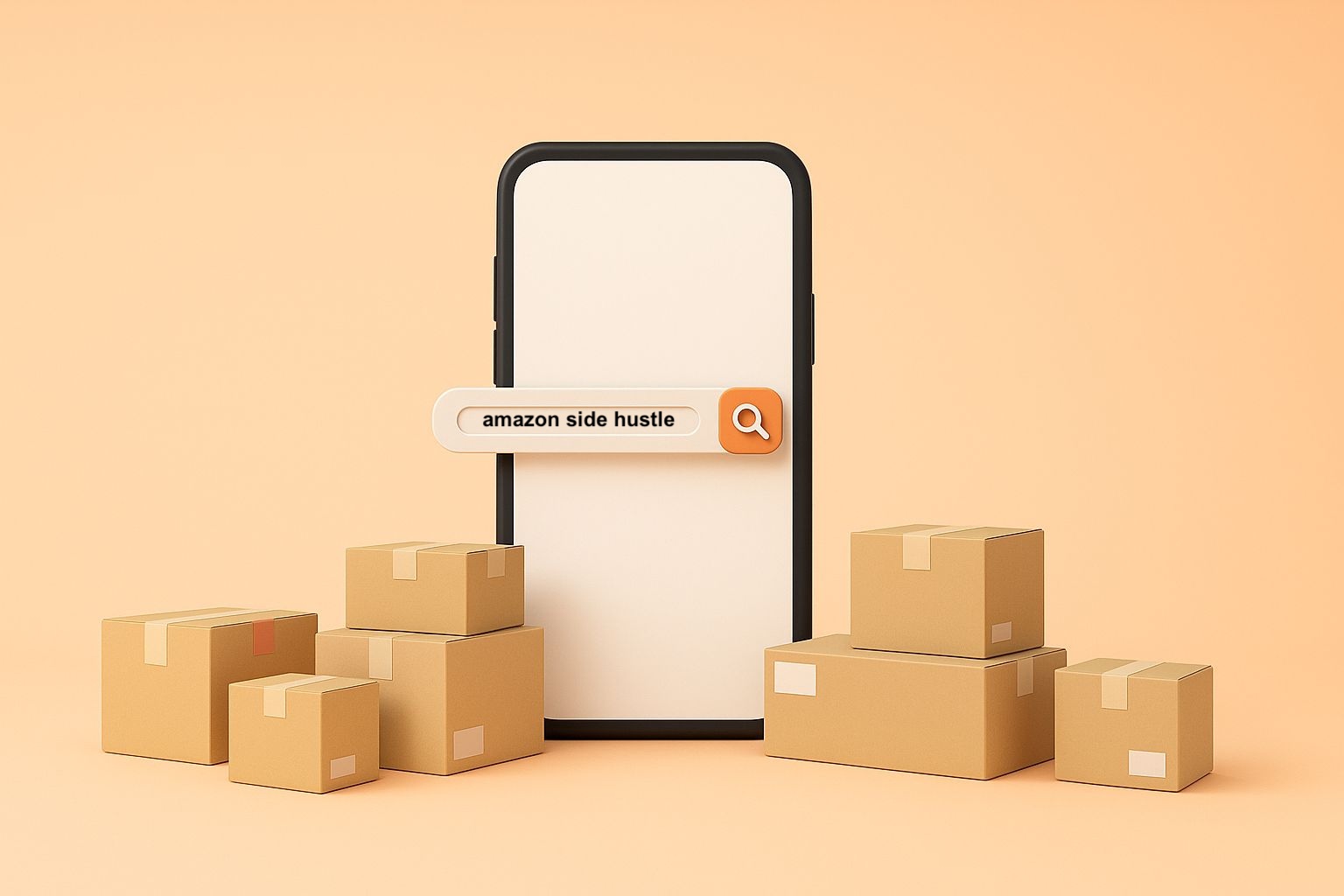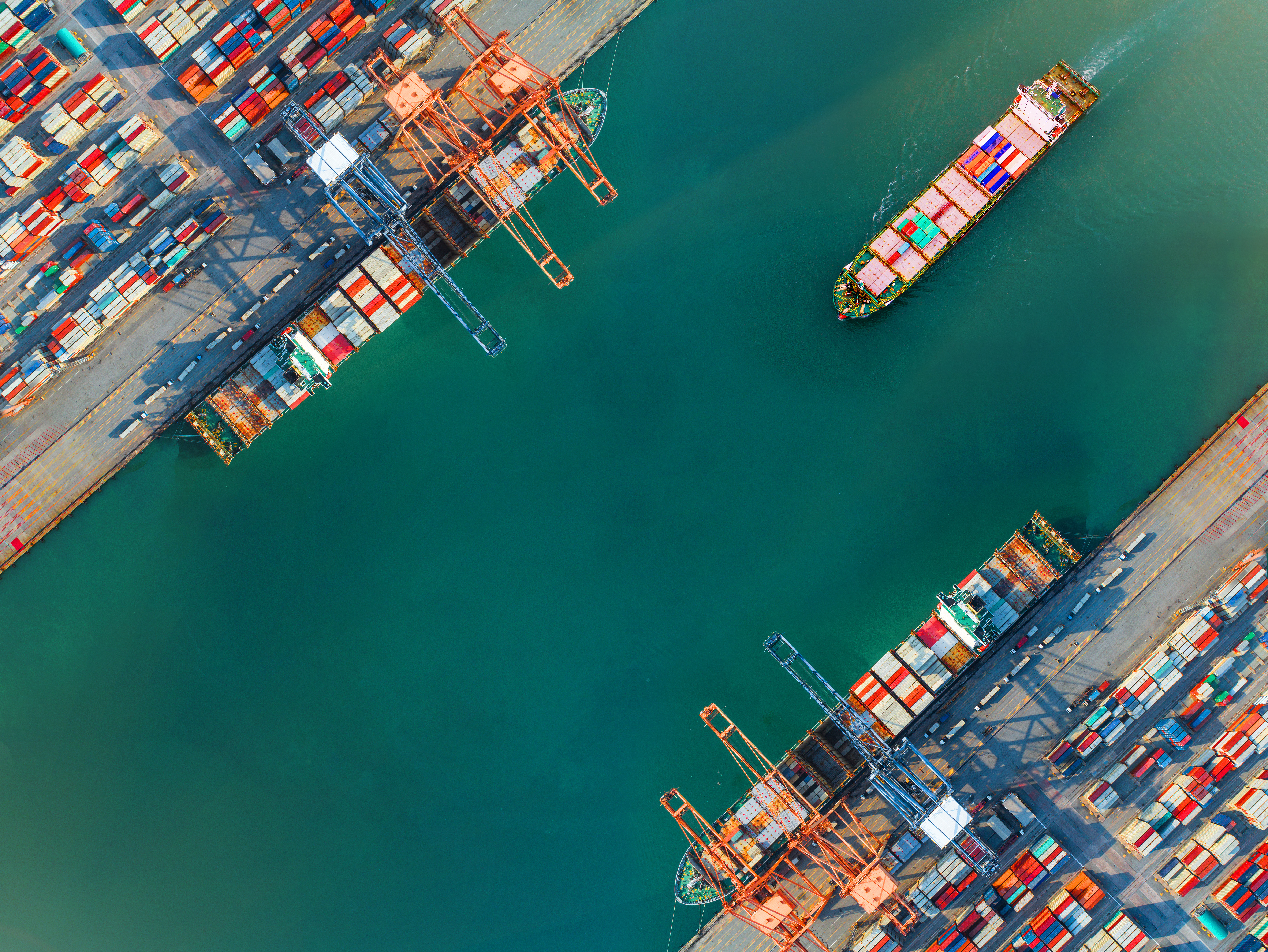Cross-Border E-Commerce with Amazon: How to Succeed in International Sales

Es gibt eigentlich keinen Grund, warum Amazon-Händler nicht international ihre Produkte verkaufen sollten. Außer vielleicht: die Bürokratie. Dem versucht der E-Commerce-Gigant allerdings Abhilfe zu schaffen, indem er den Unternehmen auf seiner Plattform die Abwicklung internationaler Geschäfte so einfach wie möglich zu machen versucht – insbesondere auf europäischer Ebene.
Vor allem für Händler von Handelsware, die mit Fulfillment by Amazon (FBA) arbeiten, ist es verhältnismäßig unkompliziert, auch europa- oder sogar weltweit Verkäufe abzuwickeln. Trotzdem gibt es einige Hürden zu meistern. Wir haben uns angeschaut, welche Möglichkeiten Sie als Händler haben, um international auf Amazon zu verkaufen.
Warum sich der internationale Verkauf auf Amazon lohnt
Der internationale Verkauf über Amazon bietet enorme Chancen für Händlerinnen und Händler, die über die Grenzen des Heimatmarkts hinausdenken. Amazon betreibt weltweit über 20 Marktplätze – darunter starke E-Commerce-Nationen wie die USA, Großbritannien, Frankreich, Italien, Japan oder Kanada. Jeder dieser Märkte bringt Millionen potenzieller Kundinnen und Kunden mit sich, die gezielt nach Produkten suchen – oft auch nach genau dem, was Sie bereits erfolgreich im Heimatmarkt verkaufen.
Durch die Expansion auf internationale Marktplätze können Sie Ihre Reichweite deutlich erhöhen und neue Umsatzpotenziale erschließen. Insbesondere, wenn Ihr Produkt in einem bestimmten Land wenig Wettbewerb hat, lohnt sich der Schritt doppelt: Sie profitieren von einer höheren Sichtbarkeit und geringeren Werbekosten.
Ein weiterer Vorteil: Amazon unterstützt Sie aktiv bei der Internationalisierung – mit Programmen wie Amazon Global Selling, integrierten Logistiklösungen (FBA) und Tools zur Steuer- und Umsatzübersicht. Dadurch wird der Einstieg auch für kleine und mittlere Unternehmen machbar.Wer früh in internationale Märkte einsteigt, verschafft sich zudem einen klaren Wettbewerbsvorteil. Sie können sich Markenbekanntheit aufbauen, bevor der Markt gesättigt ist, und so langfristig eine starke Position sichern. Viele professionelle Händler möchten außerdem auf lange Sicht mit ihrem Unternehmen expandieren, mehr Reichweite erzielen, Wachstum generieren und größeren Umsatz machen. Bis zu einem gewissen Punkt gelingt vielen Amazon-Händlern die Expansion auch national gut. Doch irgendwann taucht das Thema Internationalisierung auf der Agenda auf, denn nationale Märkte allein sind zwangsläufig begrenzt, was das Absatzpotential angeht.
Doch Achtung! Die Internationalisierung ist kein Allheilmittel für schlecht laufende Amazon-Geschäfte. Vielmehr würden in dieser Situation lediglich die Probleme des nationalen Business international ausgeweitet. Stabilisieren Sie Ihre Zahlen also erst, ehe Sie sich an neue Absatzmärkte im Ausland wagen!
Aber das stärkste Argument für die Expandierung als Amazon-Händler ist: International zu verkaufen ist vergleichsweise einfach – viel einfacher als außerhalb der Amazon-Welt, beispielsweise für Startups oder den ambitionierten Mittelstand.
Warum sollten sich Händler also mit dem zwar großen, aber doch limitierten Absatzpotential auf Amazon.de begnügen, wenn sie ebenso die spanischen, italienischen oder US-amerikanischen Käufer im Ausland erreichen könnten?
Ihre Vorteile auf einen Blick
Hat es Nachteile, auf Amazon international zu verkaufen?

Verkäufer von Handelsware ordnen ihre Produkte in aller Regel einem bereits bestehenden Listing zu. Sie müssen sich daher meist nicht um die Sprache kümmern. Private Label-Händler allerdings können davon nicht profitieren, wenn sie Ihre Amazon-Angebote zusätzlich international verkaufen wollen. Eine Übersetzung der Produktseite hinsichtlich des Produkttitels, der Produktbeschreibung und anderen relevanten Inhalten ist kaum zu umgehen. Das kann je nach Anzahl der gelisteten Produkte ein echter Kostenfaktor sein: Schlechte Übersetzungen sind ein No-go, weshalb eine professionelle Übersetzungen immer durch Profis erstellt werden sollte.
Es gibt aber noch andere To-dos für Händler, wenn die Internationalisierung ansteht. Vor allem rechtlich kommt einige Arbeit auf sie zu. Jedes Land hat eigene Vor- und Nachteile. Wer beispielsweise über den Amazon-Marktplatz in den USA verkaufen will, muss sich mit anderen Dingen beschäftigen als jemand, der Asien in den Fokus nimmt. Für Nordamerika spricht allein die Größe und das daraus resultierende Umsatzpotential, andererseits kann die Haftungsfrage und die korrekte Kennzeichnung von Produkten zum Stressfaktor werden.
USt-ID bei Lagerung im Ausland zwingend erforderlich
Eine steuerliche Registrierung in den jeweiligen Lagerländern ist beispielsweise auch bei Teilnahme am FBA-Programm innerhalb der Europäischen Union nicht zu umgehen, da das Lagern von Ware die Umsatzsteuerpflicht begründet. Händler müssen sich also um eine Umsatzsteuernummer in diesen Staaten bemühen.
Diese Pflicht zur steuerlichen Registrierung gilt europaweit auch dann, wenn Händler den Versand durch Amazon nutzen, um international zu verkaufen. Steuern müssen aber deswegen trotzdem nicht unbedingt in jedem Zielland gezahlt werden, denn in der Regel ist das Verbringen von Ware in ausländische Lager steuerfrei – vorausgesetzt, eine gültige Umsatzsteuer-Identifikationsnummer (USt-ID) des Bestimmungslandes und Nachweise für die Verbringung liegen vor. Die Krux: Amazon stellt solche Nachweise normalerweise nicht zur Verfügung. Deswegen behelfen sich viele Händler mit Pro-Forma-Rechnungen gemäß § 17c UStDV.
Ein weiteres Problem, das in einigen EU-Staaten (z. B. Polen) besteht, sind sogenannte JPK-Meldungen, die auf Basis aller Transaktionen monatlich abgegeben werden müssen und seit 2020 die klassische Umsatzsteuererklärung vollständig ersetzen. Ohne eine solche Meldung kann es passieren, dass die USt-ID im Ausland deaktiviert wird, Transaktionen damit steuerpflichtig werden und hohe Strafzahlungen auf Onlinehändler zukommen.
Daher hat es sich bewährt, bestimmte Prozesse auszulagern, um möglichst rechtssicher auf Amazon auch international verkaufen zu können – das gilt insbesondere für rechtliche und steuerliche Prozesse wie die Buchhaltung.
Ähnliche Regelungen gelten auch für Amazon-Händler, die weltweit verkaufen. Hier besteht die Steuerpflicht normalerweise im Bestimmungsland, während Ausfuhrlieferungen im Ursprungsland steuerfrei sind. Doch auch dafür gelten umfangreiche Dokumentationspflichten, für die sich Verkäufer am besten Unterstützung in Form eines Profis wie eines Steuerberaters an Bord holen.
Voraussetzungen und Strategien für den Einstieg ins Cross-Border E-Commerce

Bevor Sie auf internationalen Amazon-Marktplätzen durchstarten, sollten Sie einige grundlegende Voraussetzungen prüfen – sowohl organisatorisch als auch strategisch. Denn ein erfolgreicher Einstieg ins Cross-Border E-Commerce basiert nicht nur auf guten Produkten, sondern auch auf einer klugen Vorbereitung.
Technische und rechtliche Grundlagen:
Stellen Sie sicher, dass Ihr Amazon-Verkäuferkonto für den internationalen Verkauf freigeschaltet ist. Mit dem Programm Amazon Global Selling erhalten Sie Zugang zu internationalen Marktplätzen und können Ihre Angebote weltweit sichtbar machen. Zudem benötigen Sie, wie bereits erwähnt, je nach Zielland eine lokale Umsatzsteuerregistrierung sowie eine rechtssichere Produktkennzeichnung – in der EU ebenso wie außerhalb dieser. Auch Ihre Geschäftsprozesse – vom Rechnungswesen bis zum Kundenservice – sollten international skalierbar sein.
Marktplatzwahl: Wo starten?
Nicht jeder Markt ist automatisch der richtige für jedes Produkt. Analysieren Sie potenzielle Absatzmärkte anhand von Nachfrage, Wettbewerb, Kaufverhalten und Versandmöglichkeiten. Während der US-Markt enormes Volumen bietet, sind europäische Nachbarländer wie Frankreich, Italien oder Spanien oft einfacher zugänglich – insbesondere für Händler mit Sitz in Deutschland.
Strategie: Expandieren oder neu starten?
Überlegen Sie, ob Sie bestehende Listings internationalisieren oder den Markteintritt gezielt als Relaunch aufbauen möchten. Bei starker Konkurrenz kann es sich lohnen, Ihre Marke gezielt für den Zielmarkt zu positionieren – mit lokalisierten Texten, angepasstem Branding und maßgeschneiderten Angeboten.
Tools & Unterstützung
Nutzen Sie die von Amazon bereitgestellten Tools wie den Build International Listings (BIL)-Assistenten oder das Currency Converter Tool, um Listings zu synchronisieren und Währungsbarrieren zu überbrücken. Alternativ können Sie mit erfahrenen Agenturen oder Dienstleistern zusammenarbeiten, die auf Amazon-Expansion spezialisiert sind.
Kurz gesagt: Wer die richtigen Voraussetzungen schafft und mit einer klaren Strategie startet, legt nicht nur den Grundstein, um international zu verkaufen, sei es in Europa oder global – sondern auch für nachhaltigen Erfolg.
Logistik und Versand ins Ausland

Die Logistik ist einer der zentralen Erfolgsfaktoren im internationalen E-Commerce. Kunden erwarten heute nicht nur schnelle und zuverlässige Lieferungen – sie vergleichen auch Versandkosten, Rückgabemöglichkeiten und Kundenservice-Qualität. Wer hier überzeugt, punktet nicht nur mit dem Produkt, sondern mit dem gesamten Einkaufserlebnis.
Tipp: Viele Verkäufer nutzen spezialisierte Logistikdienstleister, die sich auf Amazon-Versand ins Ausland spezialisiert haben – inklusive Zollabwicklung, Verpackung und Lagerhaltung.
Steuerliche Anforderungen und Registrierungen in Zielmärkten
Wer international über Amazon verkauft, muss sich mit unterschiedlichen steuerlichen Regelungen auseinandersetzen – ein oft komplexes, aber unverzichtbares Thema. Je nach Zielland gelten unterschiedliche Pflichten in Bezug auf Umsatzsteuer, Registrierungen und Meldungen. Fehler oder Versäumnisse können schnell teuer werden. Das gilt auch für die Umsatzsteuer in der EU, trotz VAT-Regelungen, One-Stop-Shop, Schengen-Raum und Co.
Umsatzsteuerpflicht und Registrierungen
Sobald Sie Produkte in ein anderes Land liefern oder dort lagern (z. B. durch FBA), können steuerliche Registrierungspflichten entstehen. In der EU greift das sogenannte OSS-Verfahren (One-Stop-Shop), mit dem Sie grenzüberschreitende Verkäufe zentral melden und versteuern können – allerdings nur, wenn Sie die Ware aus einem einzigen EU-Land versenden. Lagern Sie Ihre Ware in mehreren Ländern (z. B. durch FBA in Polen oder Tschechien), benötigen Sie dort jeweils eine eigene Umsatzsteuer-Identifikationsnummer und müssen regelmäßig lokale Steuererklärungen abgeben. Auch in Ländern außerhalb der EU – wie dem Vereinigten Königreich oder den USA – gelten eigene Registrierungs- und Abgabepflichten.
Amazon unterstützt – aber Sie bleiben verantwortlich
Zwar werden Verkäufer durch Amazon an ihre Steuerpflicht erinnert und in einigen Ländern steht auch eine automatisierte Steuerberechnung zur Verfügung, doch die rechtliche Verantwortung liegt immer beim Händler selbst. Gerade bei FBA-Nutzung sollten Sie genau prüfen, wo Ihre Waren gelagert werden – denn das kann zusätzliche Steuerpflichten auslösen.
Empfehlung: Zusammenarbeit mit Steuerprofis
Für den Einstieg empfiehlt sich die Zusammenarbeit mit spezialisierten Steuerberatern oder Dienstleistern, die sich mit internationalem E-Commerce auskennen. Viele bieten Komplettlösungen für Amazon-Händler an – inklusive Umsatzsteuerregistrierung, monatlicher Meldungen und Kommunikation mit den Behörden. Auch wenn der bürokratische Aufwand zunächst abschreckend wirkt – mit der richtigen Unterstützung wird das Thema steuerliche Compliance planbar und gut beherrschbar.
Rechtliche Besonderheiten in verschiedenen Ländern
Beim internationalen Verkauf auf Amazon gelten nicht nur unterschiedliche steuerliche Vorschriften – auch das Verbraucherrecht, Produktsicherheitsanforderungen und Gewährleistungsregelungen unterscheiden sich teils erheblich von Land zu Land. Wer die länderspezifischen Richtlinien nicht kennt, riskiert Abmahnungen, gesperrte Listings oder sogar rechtliche Konsequenzen.
Produktsicherheit und Kennzeichnungspflichten
Je nach Produktart gelten in verschiedenen Ländern eigene Anforderungen an Sicherheitskennzeichen, Warnhinweise oder Prüfzeichen. Ein Beispiel: In der EU sind viele Produkte CE-kennzeichnungspflichtig – in den USA hingegen spielt das UL-Siegel eine wichtige Rolle. Auch sprachspezifische Hinweise (z. B. Gebrauchsanleitungen auf Französisch für Kanada oder Frankreich) sind gesetzlich vorgeschrieben.
Verpackungsgesetze und Recyclingpflichten
In vielen Ländern gibt es gesetzliche Vorschriften zur Rücknahme oder Registrierung von Verpackungen – z. B. die Verpackungsverordnung in Deutschland (LUCID) oder ähnliche Systeme in Frankreich und Italien. Wer sich nicht registriert oder die Pflichten nicht erfüllt, darf seine Produkte dort teilweise nicht legal verkaufen.
Impressum, Rückgaberecht und Gewährleistung
Auch beim Thema Rückgaben und Gewährleistung gibt es große Unterschiede. In der EU haben Verbraucher in der Regel 14 Tage Widerrufsrecht – ohne Angabe von Gründen. In anderen Ländern gelten andere Fristen oder Bedingungen. Als Händler müssen Sie diese länderspezifischen Rechte korrekt umsetzen und auch in der Produktbeschreibung berücksichtigen. Sehr wichtig ist auch das Impressum. Diese Pflicht besteht in sehr vielen Ländern.
Amazon-spezifische Anforderungen je Marktplatz
Zusätzlich zu gesetzlichen Vorgaben stellt auch Amazon selbst spezifische Anforderungen je Marktplatz – z. B. an Produkttitel, Kategorisierung, Produktbilder oder Inhaltsrichtlinien. Was in Deutschland zulässig ist, kann in den USA gegen Richtlinien verstoßen – und umgekehrt.
Wie funktioniert Amazon Pan EU?

Im Vergleich zum organisatorischen und juristischen Aufwand, einen eigenen Onlineshop global aufzustellen, ist es relativ einfach, über Amazon FBA international zu verkaufen. Denn wie beim inländischen Fulfillment by Amazon übernimmt der Onlineriese die Lagerung, den Versand, die Abwicklung von Rücksendungen und den Kundenservice. Besonders letzterer Punkt sollte Händler freuen, denn das bewahrt sie vor holpriger fremdsprachiger Kundenkommunikation.
Händler können sich für den Pan EU-Verkauf anmelden bzw. in den Einstellungen des Seller Central diese Option aktivieren. Im Lagerbestand ist außerdem ersichtlich, welche Produkte die Anforderungen für den paneuropäischen Verkauf erfüllen. Es sind mindestens ein aktives Listing und eine gültige ASIN erforderlich, damit Produkte über Amazon international zu verkaufen sind.
Mit der Einlieferung der FBA-Ware in einem der ausländischen Warenlager übernimmt dann Amazon Logistik und Kundenservice. Der E-Commerce-Gigant prognostiziert dafür die voraussichtlichen Bestellungen und entscheidet auf dieser Basis, in welchem Versandzentrum wie viele Einheiten von welcher Ware gelagert werden. Der Vorteil für den Verkäufer liegt aber auch in den Versandgebühren, denn er zahlt normalerweise nur die lokalen Portokosten, außerdem kann er dem Amazon-Kunden auch international einen schnellen Versand bieten und erhält das begehrte Prime-Logo.
Auch Fulfillment by Merchant (FBM) ist EU-weit möglich. Allerdings bedeutet das für Händler einen gesteigerten Aufwand: Nicht nur ist die zeitnahe Lieferung der Bestellung gefordert, es bedarf auch eines Kundenservices in der jeweiligen Landessprache und einer lokalen Anschrift für Rücksendungen. Alternativ kann auch die Erstattung internationaler Gebühren für den Versand von Retouren erfolgen.
Alternativen zum Pan EU-Versand
Wer mit Amazon international verkaufen will, hat neben dem Pan EU-Versand noch andere Versandoptionen, etwa weil nicht genügend Bestellaufkommen für Pan EU reinkommen oder sich Kosten und Nutzen nicht die Waage halten würden.
Europäisches Expansionsprogramm
Mit dem Europäischen Expansionsprogramm, englisch European Expansion Accelerator (EEA), soll es auch für kleine bis mittlere Händler mit nur wenigen Klicks möglich sein, international zu verkaufen.
Mit der Aktivierung werden innerhalb von nur drei Tagen die Kontoanmeldung, die Übersetzung und Listung von Produkten, der Versand, die Eignungsprüfung der Angebote und die Anpassung des Katalogs eingerichtet. Dabei hat der Marktplatz-Verkäufer weiterhin die Kontrolle, ob er nur auf einem, auf einigen oder auf allen Amazon-Shops innerhalb der EU handeln möchte.
Daneben gibt das Tool auch noch länderspezifische Empfehlungen ab. Insgesamt wird die Internationalisierung damit noch unkomplizierter und schneller. Händler sollten aber bedenken, dass Marktplätze zwar schnell dazu geschaltet sind, die eigenen Ressourcen aber ebenfalls Schritt halten müssen.
Der European Expansion Accelerator ist für alle professionellen Amazon-Verkäufer kostenlos, die bereits auf einem der europäischen Marktplätze verkaufen.
Lokalisierung und Kundenerwartungen im internationalen Verkauf

Ein erfolgreiches Produkt allein reicht im internationalen Handel nicht aus – mindestens genauso wichtig ist eine gezielte Lokalisierung. Denn jede Zielgruppe hat eigene Erwartungen, kulturelle Besonderheiten und Vorlieben, die Sie in Ihrem Amazon-Auftritt berücksichtigen sollten, wenn Sie eine hohe Kundenzufriedenheit erreichen wollen.
Professionelle Übersetzung von Produkttexten und Co.
Der erste Schritt zur Lokalisierung auf Amazon ist eine einwandfreie Übersetzung Ihrer Produkttexte – von Titel und Bullet Points bis hin zur Produktbeschreibung. Vermeiden Sie automatische Übersetzungen bzw. prüfen Sie diese engmaschig, denn sie wirken oft unprofessionell oder irreführend. Muttersprachliche Übersetzer mit E-Commerce-Erfahrung können Ihre Inhalte nicht nur korrekt übertragen, sondern auch kulturell anpassen – inklusive Tonalität, Stil und Keyword-Auswahl.
Angepasste Preise, Währungen und Zahlungsmethoden
Was als fairer Preis in Deutschland gilt, kann in Großbritannien oder Kanada ganz anders wahrgenommen werden. Berücksichtigen Sie lokale Preisgefüge und stellen Sie sicher, dass Ihre Angebote in der jeweiligen Landeswährung dargestellt werden. Auch bevorzugte Zahlungsmethoden – etwa Kreditkarte, Rechnung, Lastschrift oder digitale Wallets – unterscheiden sich je nach Markt.
Kundenerwartungen an Service und Lieferung
Kunden in den USA erwarten oft einen 24/7-Kundenservice – in ihrer Landessprache und mit schneller Reaktionszeit. In Frankreich oder Spanien legen Käufer besonders viel Wert auf detaillierte Produktinformationen und eine klare Rückgaberichtlinie. Achten Sie darauf, diese Erwartungen gezielt zu bedienen – z. B. durch lokalen Support oder durch einen Fulfillment-Service, der Rücksendungen vereinfacht.
Kulturelle Feinheiten im Verkauf berücksichtigen
Auch visuelle Elemente wie Produktbilder oder Marketing-Texte sollten dem kulturellen Kontext angepasst sein. Ein Beispiel: Während in Deutschland nüchterne Informationen geschätzt werden, funktionieren in Italien oder den USA emotionale Texte oft besser. Wer hier lokal denkt, stärkt nicht nur die Conversion Rate – sondern auch das Vertrauen in die Marke.
Der umgekehrte Weg: Kein ausländischer Versand gewünscht
Es kann vorkommen, dass Verkäufer auf Amazon nicht länger international verkaufen wollen. Deaktivieren können Händler die Funktion jederzeit. Gründe gibt es viele, etwa ein exorbitantes Bestellaufkommen, ein sehr hoher Aufwand Aufwand oder Probleme mit der Umsatzsteuerregistrierung.
Dazu muss erstens das Listing auf anderen Marktplätzen deaktiviert werden, was in der Regel über das Seller Central unter dem Menüpunkt „Lagerbestand“ → „Weltweit verkaufen“ möglich ist. Hier können einzelne Marketplaces deaktiviert werden, sodass lediglich Amazon.de übrig bleibt.
Zweitens können Händler auch den weltweiten Versand ausschließen, also beispielsweise von Bestellungen über Amazon.de nach Frankreich oder Spanien. Dies ist in den Versandeinstellungen möglich. Dann können Kunden aus dem Ausland auch nicht mehr über Amazon.de die Produkte des Verkäufers beziehen.
Wer lediglich einige Produktkategorien oder einzelne Amazon-Produkte nicht international verkaufen will, kann diese in den FBA-Einstellungen ausschließen: Versand durch Amazon → Einstellungen → Versandprogramme und Exporteinstellungen → Produkte ausschließen.
Fazit: Vergleichsweise einfach zu bewerkstelligen

International zu verkaufen ist auf Amazon vergleichsweise einfach. Das ist auch kein Wunder: Je größer Amazon wird, desto mehr Umsatz spült dies auch in die Kassen des Onlineriesen und viele Kunden stört es nicht, über Amazon Waren international zu kaufen.
Insbesondere der Versand über FBA im Rahmen des Pan EU-Programms oder eines anderen Services ist für Verkäufer schnell umsetzbar und erschließt mit einem Schlag den europäischen Amazon-Kosmos mit Spanien, Frankreich, Italien und so weiter.
Trotzdem sollten die Hürden nicht unterschätzt werden, vor allem wenn Händler auch in Drittstaaten außerhalb der Europäischen Union liefern wollen. Hier ist die Hilfe eines entsprechenden Fachanwalts nur wärmstens zu empfehlen, können dort doch weitaus größere rechtliche Unterschiede zu bewältigen sein, um über Amazon international zu verkaufen.
Häufig gestellte Fragen
Für den internationalen Verkauf über Amazon benötigen Sie ein freigeschaltetes Verkäuferkonto, eine klare Logistikstrategie, ggf. steuerliche Registrierungen im Zielland sowie lokalisierte Produktangebote. Amazon bietet dazu Programme wie Global Selling und FBA an.
Mit Amazon Global Selling können Sie in über 20 Länder verkaufen, darunter USA, Kanada, Großbritannien, Deutschland, Frankreich, Spanien, Italien, Japan und Australien. Die Auswahl des richtigen Marktplatzes hängt von Ihrem Produkt und Ihrer Zielgruppe ab.
Ja, in vielen Fällen. Sobald Sie im Ausland lagern oder eine Lieferschwelle überschreiten, ist eine Umsatzsteuerregistrierung im jeweiligen Land erforderlich. In der EU kann das OSS-Verfahren eine zentrale Lösung sein – jedoch nicht bei FBA-Lagerung im Ausland.
Bei Amazon FBA versenden Sie Ihre Produkte an ein Amazon-Lager im Zielland. Amazon übernimmt dann die komplette Logistik inklusive Versand, Retouren und Kundenservice. Das vereinfacht den Einstieg erheblich, erfordert aber steuerliche und rechtliche Vorbereitung.
Sehr wichtig. Professionell übersetzte Texte, landestypische Zahlungsmethoden, angepasste Preise und lokaler Kundenservice sind entscheidend für den Erfolg im Ausland. Lokalisierung erhöht nicht nur die Conversion Rate, sondern stärkt auch das Vertrauen der Käufer.
Bildnachweise in der Reihenfolge der Bilder: © william william – unsplash.com / © Valentin Antonucci – pexels.com / © Igor Miske – unsplash.com / © Adrian Sulyok – unsplash.com / © UX Indonesia / © Salih – stock.adobe.com









